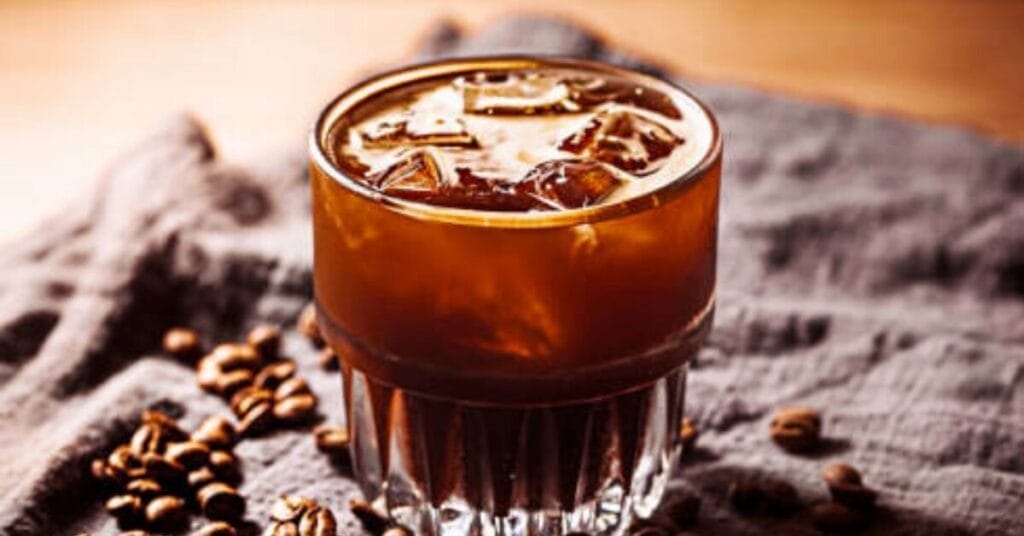Can ground coffee be used for cold brew? The answer is a resounding yes! Cold brew coffee has gained immense popularity for its smooth and rich flavor profile, and using ground coffee is a convenient and accessible way to enjoy this refreshing beverage.
Ground coffee is a versatile option for cold brew, offering a range of flavor possibilities based on the coffee beans and grind size chosen. Some people are also concerned about whether grinding coffee beans in a blender is possible.
The coarser grind typically associated with cold brew allows for a slower extraction process, resulting in a less acidic and milder mixture.
Whether you prefer a single-origin specialty coffee or a blend, ground coffee opens up a world of possibilities for creating your perfect cold brew concoction.
This method is practical and ensures that you can easily enjoy a delicious cup of cold brew using the coffee grounds you already have on hand.
If you’re wondering about using ground coffee for cold brew, rest assured that it’s a fantastic and flavorful choice.
Table of Contents
Can Ground Coffee be Used for Cold Brew: Can You Use Fine Ground Coffee for Cold Brew?

While it is not the traditional choice, you can use fine ground coffee for cold brew.
However, it’s essential to note that using a finer grind may result in a different flavor profile than the coarser grind typically recommended for cold brew.
The finer particles can lead to a faster extraction process, potentially resulting in a bolder and more acidic mixture.
Experimentation is vital – fine ground coffee might be a suitable option if you enjoy a more potent and intense cold brew.
Adjusting the steeping time can also help control the extraction.
Ultimately, choosing between fine or coarse grind for cold brew depends on your preference and taste preferences.
Try it, and find the perfect balance of grind size and steeping time to create a cold brew that suits your palate.
How to Make an Iced Coffee with Ground Coffee?

Making iced coffee with ground coffee is a simple and refreshing process.
Here’s a basic recipe to guide you:
Ingredients:
- Coarsely ground coffee (medium to dark roast) – about 1/2 cup
- Cold or room temperature water – 2 cups
- Ice cubes
- Milk or cream (optional)
- Sweetener (optional)
- Flavorings like vanilla or caramel syrup (optional)
Grinding & Brewing:
Start by coarsely grinding your coffee beans.
The coarse grind is preferred for iced coffee to prevent over-extraction.
Place the coarsely ground coffee in a large jar or pitcher.
Add cold or room-temperature water to the coffee grounds.
Stir the mixture to ensure all the coffee grounds are saturated.
Steeping & Strain the Coffee:
Cover the jar or pitcher and let the coffee steep in the refrigerator for at least 12 hours or overnight.
This slow steeping process helps extract the flavors without making the coffee bitter.
After steeping, strain the coffee using a fine-mesh sieve or cheesecloth to separate the grounds from the liquid.
You can test it a second time if you prefer a cleaner brew.
Serve Over Ice & Add Extras (Optional):
Fill a glass with ice cubes and pour the cold-brewed coffee over the ice.
Customize your iced coffee by adding milk or cream for a creamier texture.
Sweeten to taste with sugar, syrup, or a sugar alternative.
You can also experiment with flavorings like vanilla or caramel.
Stir & Enjoy:
Give your iced coffee a good stir to combine any added ingredients.
Sip and savor the refreshing and flavorful homemade iced coffee.
Adjust the coffee-to-water ratio, steeping time, and additional ingredients based on your preferences.
This method allows you to enjoy a delicious cold coffee beverage without specialized equipment.
How to Reuse Coffee Grounds for Cold Brew [Step-by-Step Recipe]:
![How to Reuse Coffee Grounds for Cold Brew [Step-by-Step Recipe]:](https://eazvucieidz.exactdn.com/wp-content/uploads/2023/12/5-2-1024x536.jpg?strip=all)
Yes, you can absolutely reuse coffee grounds for cold brew.
While coffee grounds are typically used only once for hot brewing methods like drip or espresso, they can be reused for cold brew due to the differences in extraction.
- Brew a pot of coffee using your favorite method.
- After the coffee cools, strain it into a glass jar or pitcher.
- Allow the coffee grounds to dry.
- Store the dried grounds in the fridge for future use; enjoy over the next few days.
- Add more water to the strained coffee and stir well for a new batch of cold brew.
- Adjust the grind size based on your desired coffee strength.
- Refrigerate the cold brew and savor it over the next few days.
- This straightforward process allows you to maximize your coffee grounds, providing a sustainable and convenient way to enjoy cold brew multiple times. Experiment with the grind size to tailor the strength to your liking and relish the freshness of homemade cold brew.
How to Filter Fine Coffee Grounds from Cold Brew?

Filtering acceptable coffee grounds from cold brew can be done quickly with a few simple steps.
Here’s a guide to help you achieve a smooth and sediment-free cold brew:
Materials Needed:
- Cold brew concentrate with acceptable grounds
- Fine-mesh sieve or coffee filter
- Pitcher or jar
- Patience
- Instructions:
Prepare Cold Brew and select a Filtering Method:
Start with your cold brew concentrate that contains acceptable coffee grounds.
Ensure it has been steeped for the desired time to extract the flavors.
Choose a filtering method based on what you have available.
A fine-mesh sieve or a coffee filter can be effective.
If using a sieve, ensure it has a fine mesh to capture the smaller grounds.
Place Filter Over Pitcher and pour Cold Brew Through the Filter:
If using a sieve, position it over a pitcher or jar.
If using a coffee filter, attach it securely to the top of the container.
Slowly pour the cold brew concentrate through the filter.
Allow gravity to work, and avoid pressing or forcing the liquid through to prevent stirring up the grounds.
Wait Patiently & Discard Grounds:
Filtering may take some time as the liquid gradually passes through the fine-mesh sieve or coffee filter.
Be patient to ensure a clean and precise result.
Once the cold brew has been filtered, discard or compost the retained coffee grounds.
You now have a smoother and sediment-free cold medicine ready to be enjoyed.
Store & Serve:
Transfer the filtered cold brew into a clean container and store it in the fridge.
Serve over ice, dilute with water or milk as desired, and savor the refreshing cold brew without acceptable grounds.
By following these steps, you can effectively filter out acceptable coffee grounds, enhancing the clarity and quality of your cold brew.
What is the Best Ratio of Coffee Grounds to Water?
The ideal coffee grounds-to-water ratio can vary based on personal preference and your brewing method.
However, a common starting point for making a balanced cup of coffee is the “Golden Ratio,” generally accepted as 1:15 or 1 gram of coffee to 15 grams of water.
Here are some guidelines for different brewing methods:
Drip Coffee Makers: Use 1 to 2 tablespoons of coffee grounds per 6 ounces of water.
Pour-Over: Start with a ratio of 1:15 and adjust based on your taste preferences. For example, use 20 grams of coffee for 300 grams of water.
French Press: A coarser grind is suitable. Use a ratio of 1:12 to 1:15. For example, 30 grams of coffee for 360 grams of water.
Espresso: Espresso typically has a finer grind. A standard ratio is around 1:2, meaning 18 grams of coffee for about 36 grams of water.
Cold Brew: Cold brew often requires a higher coffee-to-water ratio due to the extended steeping time. A standard ratio is 1:7 to 1:10. For example, use 200 grams of coffee for 1,400 grams of water.
These ratios provide a starting point but feel free to experiment and adjust based on your taste preferences.
Factors such as the type of coffee bean, grind size, and water quality can also influence the final flavor, so don’t hesitate to tailor the ratio to your liking.
Remember that using a scale to measure coffee and water can lead to more accurate and consistent results.
Steps for Making Cold Brew Coffee

Ensure your choice of coffee beans is optimal for crafting a delicious cold brew, selecting only the finest chilled brew beans.
Certainly! Here are the steps for making cold brew coffee:
Cold Brew Ingredients
- Coarsely ground coffee
- Cold or room temperature water
Prepare & Chill Cold Brew
Start by combining coarsely ground coffee and cold or room-temperature water in a jar or pitcher.
The general ratio is around 1 cup of coffee grounds to 4 cups of water.
Adjust according to taste preferences.
Stir the mixture well to ensure saturation, then cover the jar or pitcher.
Place it in the refrigerator and let it steep for an extended period, preferably 12 to 24 hours.
The longer steeping time contributes to a smoother and less acidic flavor.
Filter it
After steeping, filter the cold brew to remove the coffee grounds.
Use a fine-mesh sieve, cheesecloth, or a dedicated cold-brew coffee filter.
Strain the liquid into a clean jar or pitcher, ensuring a smooth and sediment-free result.
Serve it
Once filtered, your cold brew is ready to be served.
Dilute it with water or milk if desired, add ice cubes, and customize it with sweeteners or flavorings to suit your taste.
Cold brew is often enjoyed over ice for a refreshing and energizing beverage.
Experiment with the coffee-to-water ratio, steeping time, and additional ingredients to find the perfect balance that suits your preferences.
Making cold brew at home provides a versatile and customizable way to enjoy this popular, smooth coffee variation.
What Grind Size Is Best For Cold Brew?
A coarse grind size is the best choice for cold-brew coffee.
The coarse grind is crucial because it allows for a slower extraction process during the extended steeping time, resulting in a smoother and less acidic brew.
The larger coffee particles reduce the risk of over-extraction, preventing the coffee from becoming bitter.
When preparing a cold brew, aim for a grind size similar to that used for a French press.
This ensures the coffee grounds are large enough to be effectively filtered out, producing a clean and sediment-free beverage.
Experimenting with the grind size can be helpful, as personal preferences vary.
However, as a starting point, go for a coarser grind to achieve the optimal balance of flavor and extraction for a delicious and refreshing cold brew experience.
Why Does My Cold Brew Taste Weak?

Several factors may contribute to the issue if your cold brew needs to be stronger.
Here are some common reasons and solutions:
Coffee-to-Water Ratio & Grind Size:
You may be using too little coffee relative to the amount of water.
Adjust the ratio by increasing the coffee grounds for a more robust flavor.
If the coffee grounds are too coarse, they may need to extract more flavor during the steeping process.
Try using a slightly finer grind to enhance the extraction.
Steeping Time:
The duration of the steeping process is crucial.
If your cold brew steeps for too short, it may taste weak.
To extract more flavor, experiment with longer steeping times, preferably between 12 to 24 hours.
Freshness of Beans & Water Quality:
The freshness of the coffee beans also plays a role.
Ensure you’re using recently roasted beans for the best flavor.
The quality of water used can impact the taste.
Use filtered or bottled water to avoid any off-flavors that may affect the overall strength of your cold brew.
Dilution:
Diluting the cold brew with too much water or milk when serving can contribute to a weaker taste.
Adjust the dilution to your liking.
Adjustments for Personal Preference:
Taste is subjective, and what might be weak for one person could be perfect for another.
Experiment with the variables (ratio, grind size, steeping time) to find the strength that suits your preferences.
Addressing these factors allows you to troubleshoot and adjust your cold brew-making process to achieve a more robust and satisfying flavor.
It may take some experimentation, but finding the right balance will enhance the overall quality of your cold brew.
Can I Reuse Cold Brew Coffee Grounds?

Certainly! You can repurpose cold brew coffee grounds for a second batch or other applications, albeit with a milder flavor than the initial brew.
One option is to create a weaker second batch by adjusting the coffee-to-water ratio and extending the steeping time.
While it won’t match the intensity of the first brew, it still offers a satisfactory flavor.
Alternatively, blend the ground used with fresh ones to enhance complexity in a new batch.
These spent grounds can also be utilized in cooking or baking, imparting a subtle coffee essence to dishes like desserts or meat rubs.
Furthermore, the nutrient-rich nature of coffee grounds makes them excellent natural fertilizer for plants, contributing to soil structure and providing essential nutrients.
Combine the settings with coconut or carrier oil for skincare to craft a DIY coffee scrub for exfoliation.
Additionally, dried beds can be a natural deodorizer in the refrigerator or freezer.
Ensure the used grounds are thoroughly dried before storage to prevent mold growth.
Repurposing cold brew coffee grounds may not replicate the initial robustness.
Still, it presents a sustainable approach to maximizing coffee usage and minimizing waste.
Cold Brew Recipes

Certainly! Here are two popular cold-brew coffee recipes:
Vanilla Sweet Cream Cold Brew:
Ingredients:
- 1 cup coarsely ground coffee
- 4 cups cold or room temperature water
- 1/2 cup sweetened condensed milk
- 1/2 cup whole milk
- 1 tablespoon vanilla extract
Instructions:
- Follow the classic cold brew recipe.
- Mix sweetened condensed milk, whole milk, and vanilla extract in a separate container.
- Pour cold brew over ice and top with the vanilla sweet cream mixture.
- Stir and savor the sweet and creamy delight.
Mocha Cold Brew:
Ingredients:
- 1 cup coarsely ground coffee
- 4 cups cold or room temperature water
- 2 tablespoons cocoa powder
- 1/4 cup sugar
- 1/2 cup milk
- Whipped cream (optional)
Instructions:
- Follow the classic cold brew recipe.
- In a separate bowl, mix cocoa powder and sugar.
- Add a small amount of brewed cold brew to create a paste, then gradually stir in the rest.
- Add milk and stir until well combined.
- Serve over ice and top with whipped cream if desired.
Feel free to adjust the ingredient quantities and ratios to suit your taste preferences. Cold brew recipes are versatile, allowing you to experiment with flavors and customize your coffee experience.
Can Ground Coffee be used for Cold Brew: FAQS
How Do You Filter Sediment out of Cold Brew?
Filter cold brew slowly over a paper filter into a bowl to minimize sediment. For sediment-free French press cold brew, decant the coffee into another container.
Why is My Cold Brew so Grainy?
Ensure coarsely ground coffee resembles cornmeal, not sand, for a smoother, less gritty homemade coffee. Follow easy steps for a great cup of cold brew.
Why is Starbucks’s Cold Brew so Smooth?
Starbucks’ smooth cold brew results from a cold-steeping process with coarse coffee grounds, extracting flavor over 12–24 hours for a naturally sweet, low-acidity profile. Explore the difference between cold Beer and iced coffee with Starbucks® Coffee At Home.
What Makes Cold Brew Taste Better?
Cold brew’s superior taste is attributed to its 65% lower acidity, achieved by avoiding hot water that extracts acidic oils from coffee beans. The result is a smoother flavor, appealing to sensitive stomachs and coffee enthusiasts.
Bottom Line
In conclusion, the versatility of ground coffee for cold brew is undeniable.
Embracing this method offers a convenient solution and allows coffee enthusiasts to explore a myriad of flavors and brewing techniques.
So, can ground coffee be used for cold brew? Absolutely. It’s a practical, accessible, and flavorful choice that enables coffee lovers to craft their perfect chilled concoction easily.
Whether you opt for a single-origin delight or a carefully curated blend, ground coffee is a reliable companion for refreshing and delicious cold brew creations.
Elevate your coffee journey by embracing the convenience and richness that ground coffee brings to the world of cold brew.







